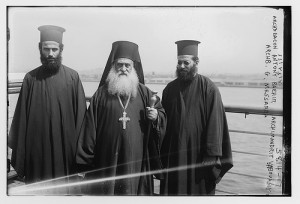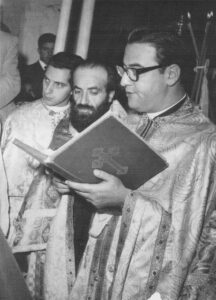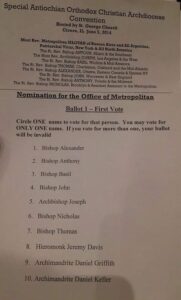
Archdeacon Antony Bashir, Metropolitan Gerasimos Messara, and Archimandrite Victor Abo-Assaley upon their arrival in America in 1922
The recent retirement of Metropolitan Joseph has left the Antiochian Archdiocese of North America without a primate. In the coming months, the Archdiocese will undoubtedly hold a special convention to nominate candidates to be the next Metropolitan, and then the Holy Synod of Antioch will elect one of those nominees. Remarkably, this will be just the fifth election of a Metropolitan in the 100-year history of the Archdiocese (which was established in 1923). Today, we’ll review the previous four elections.
Prior to 1923, the Patriarchate of Antioch did not have an official presence in North America. St Raphael Hawaweeny established the Syro-Arab Mission under the Russian Church in 1895, and after his consecration as a bishop in 1904, he was ambiguous about his relationship with Antioch, on the one hand referring to his structure as a vicariate of the Russian Archdiocese, on the other calling it a “diocese of Antioch.” For a longer discussion about the ambiguous status of St Raphael and his vicariate/diocese, see my article “Who was St. Raphael under – Antioch or Russia?”
Following St Raphael’s death in 1915, a period of chaos fell upon the Syrians/Antiochians in America. There was no obvious successor, and the clergy and faithful split into “Russy” and “Antacky” factions: the Russy, led by Bishop Aftimios Ofiesh, favored affiliation with the Russian Church, while the Antacky, led by Metropolitan Germanos Shehadi, preferred allegiance to Antioch. But Metropolitan Germanos was not, in fact, an authorized representative of the Patriarchate of Antioch. He had come to America in 1914, with St Raphael’s blessing, to raise money for an agricultural school in his Archdiocese of Baalbek, but he took a liking to America and, in the wake of St Raphael’s untimely death, he decided to stay and attempt to set up his own archdiocese. Throughout the late teens and early twenties, the Syrians/Antiochians were hopelessly divided.
In 1922, the Patriarchate of Antioch sent a delegation to America, led by Metropolitan Gerasimos Messara of Beirut, who was joined by Archimandrite Victor Abo-Assaly and Archdeacon Antony Bashir. Ostensibly, the purpose of the delegation was to attend the General Convention of the Episcopal Church, in Portland, Oregon. But the real purpose was to bring order to the chaotic Antiochian situation in North America. In June 1923, Metropolitan Gerasimos conveyed a message from Patriarch Gregory of Antioch: the Patriarchate of Antioch had decided establish the Archdiocese of North America, with jurisdiction over all Syrians/Antiochians in the continent. The clergy and faithful were invited to nominate three candidates to be their primate. This led to the election of Archimandrite Victor Abo-Assaly, who was consecrated Archbishop in Worcester, Massachusetts in November 1924. (Oddly, we know virtually nothing about what took place in the year and a half between the June 1923 call for nominations and the November 1924 consecration of Victor. Also, I haven’t heard anyone mention it yet, but next year is the 100th anniversary of the Antiochian Archdiocese of North America.)
Many of the Antacky parishes abandoned the rogue Metropolitan Germanos in favor of the new, legitimate Archdiocese. But Antioch’s actions ultimately didn’t resolve the chaotic North American situation, as Aftimios continued to assert his claims and Germanos remained at large, with support from a minority of the members of the Antiochian Holy Synod. The division lasted until the early 1930s, when several things happened at basically the same time: Aftimios married a young girl, his Russy successor Bishop Emmanuel died, Germanos returned to Syria and died, and Victor died. All at once, virtually every claimant left the stage. This led to the second primatial election for the Antiochians of North America.
Following Archbishop Victor’s death in 1934, Patriarch Alexander of Antioch appointed Metropolitan Theodosius Abourjaily of Tyre and Sidon as the Patriarchal Vicar for North America. Theodosius traveled throughout North America, getting feedback from the clergy and faithful. On November 10, 1935, a nominating convention was held in Detroit. This produced three nominees: Fr Antony Bashir, Fr Samuel David, and Fr Agapius Golam — all priests in the United States. Bashir received the most votes, and on February 5, 1936, the Holy Synod of Antioch elected him Metropolitan of North America. He was consecrated on April 19 in New York by bishops of Antioch and ROCOR. But on the very same day, in Toledo, Ohio, a rival minority faction organized the consecration of the #2 candidate, Samuel David, by three bishops of the Russian Metropolia (later the OCA). This marked the beginning of the “New York-Toledo schism,” which would not be healed for three decades.
Metropolitan Antony led the Archdiocese of North America for thirty years, and he and Samuel David actually got along well despite the fact that they led rival archdioceses. Antony died on February 15, 1966. Patriarch Theodosius of Antioch immediately appointed a Patriarchal Vicar, Metropolitan Elias Kurban of Tripoli, who had previously served as a priest in America. Just a month after Antony’s death, the Archdiocese held a special general assembly to nominate a successor. Five priests of the Archdiocese were listed on the ballot, including the eventual winner Fr Philip Saliba and future bishop Fr Antoun Khouri. Metropolitan Elias himself was proposed — he was eligible because he had previously served in the Archdiocese — but he declined the nomination. A couple of names were proposed from the floor of the convention, including Bishop Ignatius Hazim (the future Patriarch of Antioch), who had attended the Archdiocese convention three years earlier and was well-known and respected by the people. In the end, Fr Philip Saliba won in a landslide, with almost twice as many votes as the rest of the candidates put together.
Metropolitan Philip was primate of the Archdiocese for almost five decades, until his death in 2014. During his tenure, the Archdiocese constitution was revised several times, as were the Patriarchal constitution and bylaws. The old Patriarchal rules, following well-established practice across Orthodoxy, called for three nominees for a vacant episcopal see. In 1983, the Holy Synod amended the Patriarchal bylaws and changed the rule, now requiring six nominees rather than three. The effect of this change was to basically end the practice of local nominations across the Patriarchate of Antioch; with few exceptions, the Holy Synod now does both the nominations and the elections, without any involvement from the local clergy and faithful. North America has remained an exception: with its own constitution, it continued to follow the more traditional practice of nominating three candidates.
Metropolitan Philip died on March 19, 2014. The Patriarch appointed Metropolitan Silouan Mousi, then of Buenos Aires, to be the Patriarchal Vicar, and Silouan presided over a special convention held on June 5. The ballot for Metropolitan nominees consisted of the following men:
- Bishop Alexander
- Bishop Anthony
- Bishop Basil
- Bishop John
- Archbishop Joseph
- Bishop Nicholas
- Bishop Thomas
- Hieromonk Jeremy Davis
- Archimandrite Daniel Griffith
- Archimandrite Daniel Keller
In other words, all seven of the bishops of the Archdiocese, plus three celibate priests. Seven of the ten men on the ballot were born in America, and several were converts to Orthodoxy. The top three nominees were Archbishop Joseph, Bishop Basil, and Bishop John. Following the Archdiocesan Constitution of 2004, the Archdiocesan Synod validated the nominations, which were sent to the Holy Synod of Antioch. Four weeks later, on July 3, the Holy Synod elected Archbishop Joseph as Metropolitan.
***
What can we glean from this brief review? First of all, it’s notable that the Archdiocese has consistently sent three nominees to the Holy Synod, even in 2014. That is, despite the Patriarchal bylaws revision of 1983, which expanded the pool of nominees from three to six for all other archdioceses of the Patriarchate, North America has retained its practice of nominating three. The exceptional status of North America was affirmed when the Holy Synod approved a new constitution for the Archdiocese in 2004, which retained the three-nominee provision, and it was further affirmed in 2014, when the Holy Synod considered only the three nominees sent by the Archdiocese, rather than an expanded pool.
We can also see that every person nominated for Metropolitan of North America was a clergyman of the Archdiocese, not from outside of it. All but two of the candidates proposed for nomination have also been clergymen of the Archdiocese. The two exceptions are both from 1966, when Metropolitan Elias of Tripoli (who had previously been a priest in America) declined to be included on the ballot, and Bishop Ignatius Hazim was proposed from the floor. As noted above, Bishop Ignatius was proposed because he had visited America a few years earlier and earned the respect of the people, although in the end, he wasn’t one of the three nominees.
The Archdiocese of North America was an exceptional case back in 1923 due to its great distance from the Middle East, and it’s an exceptional case today due to its vast geographic size and its large number of clergy and faithful relative to every other archdiocese of Antioch. It’s also demographically unique, with the vast majority of its clergy and faithful being American-born, and roughly two-thirds of the clergy being converts to Orthodoxy. It will be quite interesting to see how the fifth primatial election plays itself out.
In preparing this summary, I relied a great deal on Fr Antony Gabriel’s article, “A Retrospective: One Hundred Years of Antiochian Orthodoxy in America,” from the book The First One Hundred Years: A Centennial Anthology Celebrating Antiochian Orthodoxy in North America (published by the Archdiocese in 1995). While I was working on this article, I learned the sad news of Fr Antony’s repose. May his memory be eternal.


That first picture with Met. Gerasimos and entourage could have been a rap album cover. Very interesting!
Apostle on the plain is a great book about fr Nicholas and some background to that first one. Also a great story.
This isn’t really relevant to the article as a whole, but as a point of information, the photo captioned “Metropolitan Philip reading the Gospel at his consecration” is more likely his Profession of Faith prior to consecration.
Yes, I’m sure you’re right. I’ll fix that. Thank you.
if this is to be an American church, and not an ethnic ghetto, should not the metropolitan be elected by the peoiple in America? Having a group of politically movitated foreigners in a distant foeign country make a decision for Americans, in America just does not pass the sanity test. I do not see this as being a positive move in the direction of Eastern Orthodox Chistian unity in America. The unity of all the Eastern Orthod in Ameica should be the goal, shouldn’t it? Is this not what Christ taught?